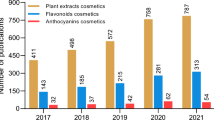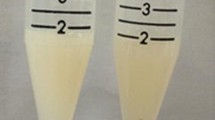Abstract
Oxidative stress is caused by reactive oxygen species (ROS) and is related to skin cancer and aging. Although anthocyanin is an effective antioxidant, has poor skin permeability and is vulnerable to temperature and pH, a suitable formulation is required. We prepared a pH-gradient loading method to prepare anthocyanin-loaded liposomes because liposomes prepared by the remote loading method exhibit high loading efficiency without anthocyanin damage. The liposome formulation could enhance anthocyanin stability, antioxidation activity and skin permeability. To compare these features, nonformulated anthocyanin (NFA) and anthocyanin-loaded liposomes prepared by the passive loading method were used as control groups. Anthocyanin-loaded HSPC liposomes prepared by the remote loading method (RAH liposomes) exhibited markedly enhanced loading efficiency (71.2%) and anthocyanin stability (85.4%) compared with control groups. The antioxidation activity of RAH liposomes was 2.1- and 1.7-fold greater than NFA and passive loading of anthocyanin in HSPC liposomes (PAH liposomes), respectively. The skin permeability of RAH liposomes was enhanced 2.9- and 2.2-fold compared with NFA and PAH liposomes, respectively. RAH liposomes maintained anthocyanin stability under in vitro physiological conditions for 14 days and exhibited enhanced ROS scavenging activity and skin permeability. Therefore, RAH liposomes represent a platform for effective anthocyanin loading and exhibited promising application for pharmaco-cosmetics.

Similar content being viewed by others
References
J. M. Matés, C. Pérez-Gómez, and I. N. J. C. B. De Castro, Clin. Chem., 32, 595 (1999).
H.-U. Simon, A. Haj-Yehia, and F. J. A. Levi-Schaffer, Apoptosis, 5, 415 (2000).
M. Ott, V. Gogvadze, S. Orrenius, and B. Zhivotovsky, Apoptosis, 12, 913 (2007).
C. S. Sander, F. Hamm, P. Elsner, and J. J. Thiele, Brit. J. Dermatol., 148, 913 (2003).
M. Rinnerthaler, J. Bischof, M. K. Streubel, A. Trost and K. Richter, Biomolecules, 5, 545 (2015).
X. Yun, V. D. Maximov, J. Yu, H. Zhu, A. A. Vertegel, and M. S. Kindy, J. Cerebr. Blood F. Met., 33, 583 (2013).
L. George, M. C. Bavya, K. V. Rohan and R. Srivastava, Colloid Surf. B, 160, 315 (2017).
J. Chen, N. Wei, M. Lopez-Garcia, D. Ambrose, J. Lee, C. Annelin, and T. Peterson, Eur. J. Pharm. Biopharm., 117, 286 (2017).
C. K. Kim, T. Kim, I. Y. Choi, M. Soh, D. Kim, Y. J. Kim, H. Jang, H. S. Kim and H. K. Park, Angew. Chem. Int. Ed., 51, 11039 (2012).
X. Wu, L. Gu, R. L. Prior, and S. McKay, J. Agr. Food Chem., 52, 7846 (2004).
P. N. Denev, C. G. Kratchanov, M. Ciz, A. Lojek, and M. G. Kratchanova, Compr. Rev. Food Sci. F., 11, 471 (2012).
J. M. Kong, L. S. Chia, N. K. Goh, T. F. Chia, and R. Brouillard, Phytochemistry, 64, 923 (2003).
O. Dangles and J. A. Fenger, Molecules, 23, 1970 (2018).
D. Jeong and K. Na, Carbohydr. Polym., 90, 507 (2012).
S. Zafra-Stone, T. Yasmin, M. Bagchi, A. Chatterjee, J. A. Vinson, and D. Bagchi, Mol. Nutr. Food Res., 51, 675 (2007).
M. P. Kähkönen, J. Heinämäki, V. Ollilainen, and M. Heinonen, J. Sci. Food Agr., 83, 1403 (2003).
Y. Liu, Y. Liu, C. Tao, M. Liu, Y. Pan, and Z. Lv, J. Food Meas. Charact., 12, 1744 (2018).
M.-J. Bermúdez-Soto, F.-A. Tomás-Barberán, and M.-T. J. F. C. García-Conesa, Food Chem., 102, 865 (2007).
E. Gris, E. Ferreira, L. Falcão, and M. Bordignon-Luiz, Food Chem., 100, 1289 (2007).
Z. Fang and B. J. T. I. F. S. Bhandari, Trends Food Sci. Tech., 21, 510 (2010).
K. Frank, E. Walz, V. Gräf, R. Greiner, K. Köhler, and H. P. Schuchmann, J. Food Sci., 77, N50 (2012).
J. Dua, A. Rana, and A. J. I. J. P. S. R. Bhandari, Int. J. Pharm. Stud Res., 3, 14 (2012).
L. Sercombe, T. Veerati, F. Moheimani, S. Y. Wu, A. K. Sood, and S. Hua, Front. Pharmacol., 6, 286 (2015).
F. Casanova and L. J. J. O. M. Santos, J. Microencapsul., 33, 1 (2016).
A. Akbarzadeh, R. Rezaei-Sadabady, S. Davaran, S. W. Joo, N. Zarghami, Y. Hanifehpour, M. Samiei, M. Kouhi, and K. Nejati-Koshki, Nanoscale Res. Lett., 8, 102 (2013).
J. M. Hwang, H. C. Kuo, C. T. Lin, and E. S. Kao, Pharm. Biol., 51, 941 (2013).
A. M. Samuni, A. Lipman, and Y. Barenholz, Chem. Phys. Lipids, 105, 121 (2000).
H. Park, J. Lee, S. Jeong, B. N. Im, M. K. Kim, S. G. Yang, and K. Na, Adv. Healthc. Mater., 5, 3139 (2016).
Author information
Authors and Affiliations
Corresponding author
Additional information
Publisher’s Note Springer Nature remains neutral with regard to jurisdictional claims in published maps and institutional affiliations.
Acknowledgments: This work was supported by Nano-Material Technology Development Program (NRF-2018M3A7B4071235) Through the National Research Foundation of Korea (NRF) funded by Ministry of Science and ICT (MSIT), and supported by the Catholic University of Korea, Research Fund, 2019.
Rights and permissions
About this article
Cite this article
Lee, C., Na, K. Anthocyanin-Loaded Liposomes Prepared by the pH-Gradient Loading Method to Enhance the Anthocyanin Stability, Antioxidation Effect and Skin Permeability. Macromol. Res. 28, 289–297 (2020). https://doi.org/10.1007/s13233-020-8039-7
Received:
Revised:
Accepted:
Published:
Issue Date:
DOI: https://doi.org/10.1007/s13233-020-8039-7




